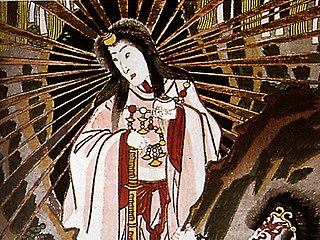
Tengu( TENG-goo, Japanese pronunciation:[teŋgɯ]) are a type of legendary creature found in Shinto belief. They are considered a type of yōkai or Shinto kami. The Tengu were originally thought to take the forms of birds of prey and a monkey deity, and they were traditionally depicted with human, monkey, and avian characteristics. Sarutahiko Ōkami is considered to be the original model of Konoha-Tengu, which today is widely considered the Tengu's defining characteristic in the popular imagination. He is the Shinto monkey deity who is said to shed light on Heaven and Earth. Some experts theorize that Sarutahiko was a sun god worshiped in the Ise region prior to the popularization of Amaterasu.

Wario's Woods is a puzzle video game developed by TEC and published by Nintendo for the Nintendo Entertainment System. It was released in Japan and North America in 1994 and Europe in 1995. A spin-off of the Mario series, players control Toad in his mission to defeat Wario, who has taken control of the Peaceful Woods. Gameplay revolves around clearing each level by using bombs to destroy groups of enemies. The game also features a multiplayer mode that allows two players to compete against each other.
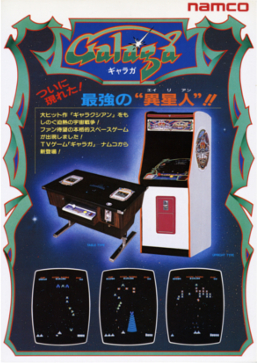
Galaga is a 1981 fixed shooter arcade video game developed and published by Namco. In North America, it was released by Midway Manufacturing. It is the sequel to Galaxian (1979), Namco's first major video game hit in arcades. Controlling a starship, the player is tasked with destroying the Galaga forces in each stage while avoiding enemies and projectiles. Some enemies can capture a player's ship via a tractor beam, which can be rescued to transform the player into a "dual fighter" with additional firepower.
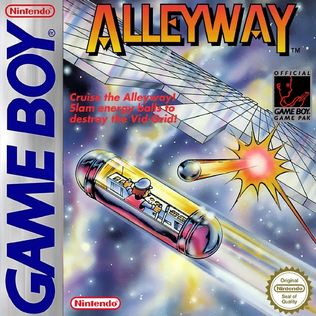
Alleyway is a 1989 video game developed by Nintendo and Intelligent Systems and published by Nintendo as a global launch title for the Game Boy. It is a Breakout clone and one of the first four games developed and released for the system. The game was released first in Japan in 1989, in North America later that year, and in Europe in 1990. It was later re-released for the Nintendo 3DS Virtual Console in June 2011, and on the Nintendo Switch Online service in May 2024.

Mega Man & Bass is an action-platform video game developed and published by Capcom. It is a spin-off game in the original Mega Man series and was originally released in Japan for the Super Famicom on April 24, 1998. It was later ported to the Game Boy Advance (GBA) handheld in 2002, and localized in English and released the following year.

Rad Racer, known as Highway Star in Japan, is a racing video game developed and published by Square for the Nintendo Entertainment System (NES) in 1987. In this game, players drive a Ferrari 328 or a generic Formula One racing machine through a racecourse. The game was released in North America and Europe months after its debut. The title became well known for being one of two titles from Square that made use of stereoscopic 3D, which was made possible by wearing a pair of anaglyph glasses. Square president Masafumi Miyamoto initially conceived the game as an opportunity for developer Nasir Gebelli to demonstrate his 3D programming skills. Gebelli developed, and often drew by hand, the graphics for the game's 3D mode.
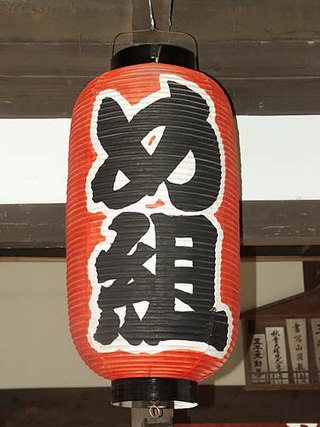
The Unfettered Shogun (暴れん坊将軍) was a Japanese television program on the TV Asahi network. Set in the eighteenth century, it showed fictitious events in the life of Yoshimune, the eighth Tokugawa shōgun.
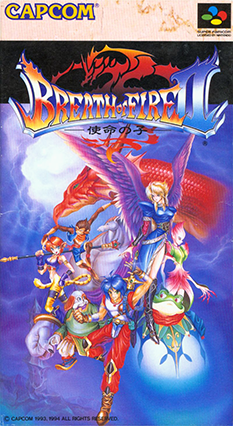
Breath of Fire II is a role-playing video game developed and published by Capcom. First released in 1994, the game was licensed to Laguna for European release in 1996. It is the second entry in the Breath of Fire series. It was later ported to Game Boy Advance and re-released worldwide. The game was released on Wii's Virtual Console in North America on August 27, 2007. Nintendo of Europe's website mistakenly announced it for release on July 27, 2007, but it was in fact released two weeks later, on August 10, 2007. In 2013, it was released for the Wii U Virtual Console. In 2016, it was released for the New Nintendo 3DS Virtual Console. In 2019, it was released for the Nintendo Switch SNES games library.
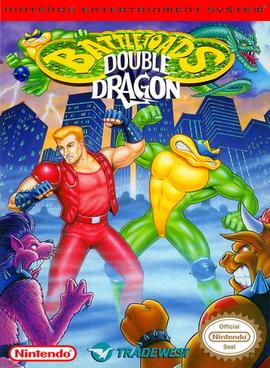
Battletoads/Double Dragon is a 1993 beat 'em up developed by Rare and published by Tradewest. It was originally released for the Nintendo Entertainment System and later ported to the Mega Drive/Genesis, Super NES, and Game Boy. Retro-bit Publishing has re-released the 8-bit NES version in early 2022 with plans to release the 16-bit versions later this year.
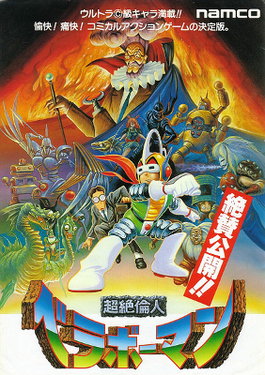
Chōzetsurin Jin Bravoman is a 1988 beat'em up arcade video game developed and published in Japan by Namco. Described as a "comical action game", the player controls the titular character, a bionic superhero with telescopic limbs, as he must defeat the villainous Dr. Bomb before he takes over the world. Bravoman can use his arms, legs and head to defeat enemies, and can also crouch and jump over them. The game ran on the Namco System 1 arcade board.

Batman: Return of the Joker is a 1991 platform video game, the follow-up to Sunsoft's first Batman game on the Nintendo Entertainment System. Unlike that game, which was based on the 1989 Batman film directed by Tim Burton, Return of the Joker is entirely self-contained and based more on the modern comic book iteration of Batman, but the Batmobile and the Batwing are featured from the 1989 film. A remake of Return of the Joker, titled Batman: Revenge of the Joker, was released on the Sega Genesis by Ringler Studios in 1992. A Super NES version of Revenge of the Joker was completed but never officially released; a ROM image surfaced online in later years.

Shinsetsu Samurai Spirits Bushidō Retsuden is a role-playing video game for SNK's Neo Geo CD system, which retells the events of Samurai Shodown and Samurai Shodown II in greater detail. It was ported to the Sega Saturn and PlayStation.

Contra is a video game series produced by Konami composed primarily of run and gun-style shooting games. The series debuted in February 1987 with the Japanese coin-operated arcade game of the same name, which has since spawned several sequels produced for various platforms.

Karnov's Revenge is a 1994 fighting game developed by Data East, released for the Neo Geo. It is the second game in the Fighter's History series. The game was later ported to the Neo Geo, Neo Geo CD and Sega Saturn home consoles.

Clash at Demonhead, known in Japan as Dengeki Big Bang!, is an action-adventure platform game released by Vic Tokai for the Nintendo Entertainment System on January 27, 1989 in Japan and December 1989 in North America.

Mystery Dungeon: Shiren the Wanderer, originally released in Japan as Fushigi no Dungeon 2: Fūrai no Shiren, is a roguelike video game developed and published by Chunsoft. It is the second entry in the Mystery Dungeon series, following 1993's Torneko no Daibōken. It was originally released for the Super Famicom in 1995 in Japan. Sega published a Nintendo DS remake in 2006 in Japan and in 2008 internationally. The remake was later ported to iOS and Android and published by Spike Chunsoft in 2019.

Section Z is a horizontally scrolling shooter by Capcom, released as an arcade video game in 1985. A home version was published for the Nintendo Entertainment System in 1987.

Meldac is a Japanese music and video game company. It was founded in July 1985 by Hiromu Takamizawa, Tohru Sasaki, Tetsu Kiso, and Hajime Toyama — all members of the now-defunct vocal group Dark Ducks — with financial backing from the Mitsubishi keiretsu and its affiliates, including former Mitsubishi Electric subsidiary Nippon Crown.

Pokémon Black Version and Pokémon White Version are 2010 role-playing video games developed by Game Freak and published by The Pokémon Company and Nintendo for the Nintendo DS. They are the first installments in the fifth generation of the Pokémon video game series. First released in Japan on 18 September 2010, they were later released in Europe, North America and Australia in 2011. Sequels to Black and White, Pokémon Black 2 and Pokémon White 2, were released for the Nintendo DS in 2012.

Captain Commando is a 1991 futuristic side-scrolling beat 'em up originally developed and published by Capcom as an arcade video game, and later ported to several other platforms. It was the seventeenth game produced for the company's CP System hardware. The game stars the titular superhero who was originally conceived as a fictional spokesman used by Capcom USA in the company's console games during the late 1980s. On September 13, 2018, Capcom announced Capcom Beat 'Em Up Bundle with Captain Commando being one of seven titles and released digitally for Nintendo Switch, PlayStation 4, Xbox One, and Windows on September 18, 2018.





















